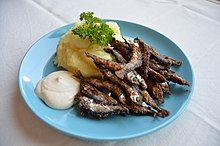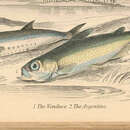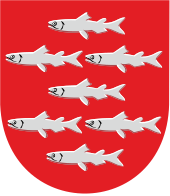Biology
provided by Arkive
In Britain the vendace occurs only as non-migratory freshwater populations, but in the Baltic it occurs as anadromous populations (they spend most of their time in saltwater and migrate to freshwater to spawn) (7). The vendace feeds primarily on free-swimming organisms such as water fleas (6) and planktonic crustaceans (5).
Spawning occurs in November and December (6); adults move to the edges of lakes, and females scatter the small two millimetre diameter yellow to orange eggs in gravely areas in still water (6). The eggs are fertilised externally and develop slowly on the bottom of the lake (7), hatching the following spring (2). Individuals are thought to live up to six years of age (2).
Conservation
provided by Arkive
The vendace is fully protected under the Wildlife and Countryside Act (1981), and both lakes are Sites of Special Scientific Interest (SSSIs) and candidate Special Areas of Conservation (2). Bassenthwaite Lake is also a National Nature Reserve managed by the National Trust. The management plan for this site takes into account the presence of vendace (3). A current conservation measure involves hatching vendace eggs from Bassenthwaite Lake in captivity and releasing the young back into the lake (11). In addition, young vendace from Bassenthwaite and Derwent Water have been released into two Scottish water bodies. A survey of water bodies in Cumbria aimed to detect suitable places for the establishment of refuge populations, however no suitable sites were found (11).
The vendace is a priority species under the UK Biodiversity Action Plan (UK BAP); the Species Action Plan aims to maintain the current populations and re-introduce the species to Scotland by 2005 (3).
Description
provided by Arkive
This vendace is one of the UK's rarest freshwater fish (2); it is a small, streamlined (2) and slim fish with a bluish green back (5), a white belly (6) and silvery flanks (5). The fins are grey in colour becoming darker towards the margins (6). It has large eyes, a relatively small mouth and an adipose fin (5). Other common names for this species include 'whitefish' and 'European cisco' in England and 'Fendas' in Welsh (7).
Habitat
provided by Arkive
Occurs in open water shoals in deep, cold lakes where the species can take refuge from hot summer temperatures (2) (6). It also requires shallow areas with a gravely substrate for spawning (7).
Range
provided by Arkive
Found in north-west Europe between the English Lake District in the east to western Russia, and from a northern extreme in Scandinavia to north western Russia reaching south to Bavaria (2). Historically this species has been recorded from just four UK lakes; two in Scotland (3), and two in the English Lake District (8). One of the Scottish populations has not been recorded since 1911 when a sewage works was built; the other Scottish population has not been recorded since the 1970s (9) and so the species is classed as extinct in Scotland (10).
Status
provided by Arkive
Classified as Data Deficient (DD) on the IUCN Red List (1), Annex III of the Bern Convention, Annex V of the EC Habitats and Species Directive, Schedule 5 of the Wildlife and Countryside Act 1981 (3), and Schedule 3 of the Conservation Regulations 1994 (4).
Threats
provided by Arkive
The vendace has faced pressure from the introduction of non-indigenous fish species, which were probably introduced by pike anglers using live bait (2). Juvenile roach compete for planktonic food with vendace, and ruffe eat vendace eggs (2). Ruffe were recorded in Derwent Water for the first time in 2001 (11). Other threats are habitat loss and pollution, particularly eutrophication resulting from nutrient enrichment (3), and siltation of spawning sites with organic matter (9). The A66 passes close to Bassenthwaite Lake; an accident involving an industrial tanker would be devastating (2).
Life Cycle
provided by Fishbase
Ascend a short distance up the rivers in shoals in late August to mid-October. Mature in the second year (lacustrine forms later) and the young ones descend in late summer (Ref. 4779).
- Recorder
- Sari Kuosmanen-Postila
Migration
provided by Fishbase
Anadromous. Fish that ascend rivers to spawn, as salmon and hilsa do. Sub-division of diadromous. Migrations should be cyclical and predictable and cover more than 100 km.
Morphology
provided by Fishbase
Dorsal spines (total): 0; Dorsal soft rays (total): 11 - 13; Analspines: 0; Analsoft rays: 13 - 17
Trophic Strategy
provided by Fishbase
Feeds on branchiopods, copepods and insects (Ref. 6258).
Biology
provided by Fishbase
Lacustrine and marine in open water. At sea, forages close to coast (Ref. 59043). Forms pelagic schools in deeper lakes (Ref. 4779). Spawns along shores, at 3-10 m depth, rarely to 22 m depth or just below surface. Spawns deeper in clear lakes and closer to surface in lakes with humic waters (Ref. 59043). Spawns on shallow sand or gravel substrate. Anadromous in the Baltic. Feeds on planktonic crustaceans (Ref. 4779).
Importance
provided by Fishbase
fisheries: commercial; aquaculture: experimental
Coregonus albula
provided by wikipedia EN
Coregonus albula, known as the vendace or as the European cisco, is a species of freshwater whitefish in the family Salmonidae. It is found in lakes in northern Europe, especially Finland, Latvia,[2] Lithuania, Sweden, Russia and Estonia, and in some lakes of Norway, the United Kingdom, northern Germany, and Poland. It is also found in diluted brackish water in the Gulfs of Finland and Bothnia, both of which are in the Baltic Sea.[3]
The length of an adult is normally about 20 cm (8 in). The maximum age is about ten years.[3]

Fried vendace is a popular summertime food in Finland.
The vendace is traditionally the most important target of freshwater fisheries in parts of Fennoscandia and Russia. Vendace roe is considered a delicacy, which has been granted a PDO status in the Swedish Bothnian Bay archipelago (Kalix löjrom).
Description
The vendace is a slim and streamlined fish with an adipose fin - an additional small fin on the back between the dorsal fin and the tail (caudal fin) which is typical in the salmon family. Its lower jaw is longer than the upper one. It is similar in appearance to both the common whitefish (Coregonus lavaretus sensu lato), whose upper jaw is longer than its lower one, and the peled (Coregonus peled), whose jaws are of equal length. The back is bluish green or brown, the flanks are silvery and the belly white. This fish seldom grows more than 30 cm (12 in) long.[4]
Biology
Vendace mainly feed on zooplankton, such as small crustaceans and their larvae, but larger fish also feed on floating insects and fish fry. The fish live in schools made up of large groups of individuals. They lay their eggs on pebbly or sandy ground, some in shallow water and others at depths of down to 20 m (66 ft). The fish mature at a young age and most spawn for the first time in their second year, but a few may breed in their first autumn.[4]
Systematics
The European vendace is very closely related to the Siberian Coregonus sardinella (sardine cisco) and also to C. peled, although phenotypic differences are clear.[5]
Within the vendace, taxonomic subdivisions have been suggested both on geographical grounds and between sympatric ecotypes. FishBase lists the British populations of vendace as a separate species, Coregonus vandesius,[6] but this distinction is not accepted by all scientists.[7]
Coregonus albula generally breeds in the autumn, but in several North European lakes distinct spring-spawning populations of vendace exist, some of which have been described as separate species: in Sweden, as Coregonus trybomi, and in two lakes of northern Germany, as Coregonus fontanae and Coregonus lucinensis. These populations are sympatric with autumn-spawning vendace and seem to have evolved post-glacially from them independently in each lake.[8][9]
See also
References
-
^ Freyhof, J. & Kottelat, M. (2011). "Coregonus albula". IUCN Red List of Threatened Species. 2011.old-form url
-
^ "repsis - Coregonus albula (L.) - Zivis - Latvijas daba".
-
^ a b Froese, Rainer; Pauly, Daniel (eds.) (2015). "Coregonus albula" in FishBase. November 2015 version.
-
^ a b "Vendace: Coregonus albula (L.)". NatureGate. Retrieved 2013-12-18.
-
^ Bernatchez L, Colombani F, Dodson JJ (1991) Phylogenetic relationships among the subfamily Coregoninae as revealed by mitochondrial DNA restriction analysis Journal of Fish Biology 39 (Suppl A):283-290.
-
^ Froese, Rainer; Pauly, Daniel (eds.) (2010). "Coregonus vandesius" in FishBase. January 2010 version.
-
^ Winfield, Ian J.; Fletcher, Janis M.; James, J. Ben (2004). "Conservation ecology of the vendace in Bassenthwaite Lake and Derwent Water, U.K." (PDF). Annales Zoologici Fennici. 41: 155–164.
-
^ Schulz, M.; Freyhof, J. (October 2002). "Coregonus fontanae, a new spring-spawning cisco from Lake Stechlin, northern Germany (Salmoniformes: Coregonidae)" (PDF). Ichthyological Exploration of Freshwaters. 14 (3): 209–216. ISSN 0936-9902. Archived from the original (PDF) on 2004-01-21.
-
^ Schulz, M.; Freyhof, J.; Saint‐Laurent, R.; Østbye, K.; Mehner, T. & Bernatchez, L. (March 13, 2006). "Evidence for independent origin of two spring‐spawning ciscoes (Salmoniformes: Coregonidae) in Germany". Journal of Fish Biology. 68 (A): 119–135. doi:10.1111/j.0022-1112.2006.01039.x. ISSN 0022-1112. Archived from the original on January 5, 2013.

- license
- cc-by-sa-3.0
- copyright
- Wikipedia authors and editors
Coregonus albula: Brief Summary
provided by wikipedia EN
Coregonus albula, known as the vendace or as the European cisco, is a species of freshwater whitefish in the family Salmonidae. It is found in lakes in northern Europe, especially Finland, Latvia, Lithuania, Sweden, Russia and Estonia, and in some lakes of Norway, the United Kingdom, northern Germany, and Poland. It is also found in diluted brackish water in the Gulfs of Finland and Bothnia, both of which are in the Baltic Sea.
The length of an adult is normally about 20 cm (8 in). The maximum age is about ten years.

Fried vendace is a popular summertime food in Finland.
The vendace is traditionally the most important target of freshwater fisheries in parts of Fennoscandia and Russia. Vendace roe is considered a delicacy, which has been granted a PDO status in the Swedish Bothnian Bay archipelago (Kalix löjrom).
- license
- cc-by-sa-3.0
- copyright
- Wikipedia authors and editors



 Fried vendace is a popular summertime food in Finland.
Fried vendace is a popular summertime food in Finland.